CHINA-BHUTAN
1. Context
The 25th round of boundary talks between Bhutan and China, held in Beijing, has marked a significant milestone in the ongoing efforts to resolve their border disputes. These talks come after a seven-year hiatus and represent a positive step forward since their last discussions in 2016. The pause in negotiations was partly due to the Doklam Standoff between Indian and Chinese armies in 2017 and the COVID-19 pandemic from 2019 to 2021. During this break, both countries engaged in talks at various levels, particularly after China's threat to open a new front for a border dispute in Bhutan's east.
2. China Bhutan Relations
- China and Bhutan have a long and complex history. The two countries first established contact in the 7th century, and they have had several disputes over the centuries.
- In the early 20th century, China invaded Bhutan, but Bhutan was able to maintain its independence with British support.
- After Bhutan gained independence from India in 1949, it pursued a policy of isolationism. However, Bhutan began to open up to the outside world in the 1970s, and it established relations with China in 1979.
- China and Bhutan share a 470-kilometer border. The two countries have no formal diplomatic relations, but they have maintained dialogue and cooperation on various issues, including border talks, trade, and investment.
- Trade between China and Bhutan has grown significantly in recent years. China is now Bhutan's largest trading partner. China exports a variety of goods to Bhutan, including machinery, electronics, and textiles. Bhutan exports hydropower and other natural resources to China.
- Chinese investment in Bhutan has also increased in recent years. Chinese companies are involved in a variety of projects in Bhutan, including infrastructure development, hydropower, and mining.
3. The 3-Step Roadmap
The 3-Step Roadmap, initiated in 2021, aims to facilitate border resolution between Bhutan and China. This roadmap involves three key phases:
- The first step is to reach a mutual agreement on the border in principle.
- The second step entails conducting on-site inspections of the border areas to ensure a clear understanding of the territory involved.
- The final step involves the formal demarcation of the border, which would provide a clear delineation of Bhutanese and Chinese territory.
It's important to note that Bhutan and China do not have diplomatic relations, as Bhutan has maintained a policy of not establishing diplomatic ties with any of the United Nations Security Council's permanent members.

4. India's Concerns and Observations
India is closely monitoring the Bhutan-China border talks due to several reasons:
- India's relations with China deteriorated significantly following the border standoff at the Line of Actual Control in 2020. Therefore, any signs of closer ties between China and one of India's closest neighbours raise concerns in New Delhi.
- India is particularly concerned about the demarcation discussions over Doklam. China has proposed an agreement to "swap" areas under Bhutanese control in Doklam with areas it claims in Jakarlung and Pasamlung. The Doklam region is strategically significant as it is close to India's Siliguri corridor, a narrow strip connecting India's northeastern states to the rest of the country. India is wary of China gaining access to areas near this critical corridor.
- India is also apprehensive about China's demand for full diplomatic relations with Bhutan and the establishment of a Chinese embassy in Thimphu. Given India's concerns with Chinese projects and influence in neighbouring countries like Bangladesh, Nepal, Sri Lanka, and the Maldives, any Chinese presence in Bhutan could pose challenges for India.
However, Bhutan's leadership has assured that all decisions will consider India's interests and consult with India on matters of concern.
5. Conclusion
The recent border talks and the progress made in the Bhutan-China border resolution process have garnered significant attention, especially from India, as the outcome could have implications for regional geopolitics and India's strategic interests.
|
For Prelims: China, Bhutan, India, COVID-19 pandemic, Line of Actual Control, Doklam, Siliguri corridor,
For Mains:
1. Discuss the implications of the China-Bhutan border talks for India's security and strategic interests. (250 Words)
|
|
Previous Year Questions
Prelims
1. Belt and Road Initiative’ is sometimes mentioned in the news in the context of the affairs of (UPSC CSE 2016) (a) African Union Answer: D 2. The South China Sea Dispute involves which of the following countries? (CDS GK 2019)
1. China
2. Vietnam
3. Malaysia
4. Indonesia
Select the correct answer using the code given below.
A. 1 and 4 B. 1 and 2 only C. 1, 2 and 3 D. 2, 3 and 4
Answer: C
3. Which one of the following statements best reflects the issue with Senkaku Islands, sometimes mentioned in the news? (UPSC CSE 2022)
A. It is generally believed that they are artificial islands made by a country around South China Sea.
B. China and Japan engage in maritime disputes over these islands in East China Sea.
C. A permanent American military base has been set up there to help Taiwan to increase its defence capabilities.
D. Though International Court of Justice declared them as no man's land, some South-East Asian countries claim them.
Answer: B
4. LAC (Line of Actual Control) is an effective border between India and ______. (SSC CHSL 2021)
A. Pakistan B. Bhutan C. Sri Lanka D. China
Answer: D
5. The Line of Actual Control (LAC) separates (Karnataka Civil Police Constable 2020)
A. India and Pakistan
B. India and Afghanistan
C. India and Nepal
D. India and China
Answer: D
6. In the context of vaccines manufactured to prevent COVID-19 pandemic, consider the following statements: (UPSC 2022)
1. The Serum Institute of India produced COVID-19 vaccine named Covishield using mRNA platform.
2. Sputnik V vaccine is manufactured using vector based platform.
3. COVAXIN is an inactivated pathogen based vaccine.
Which of the statements given above are correct?
A. 1 and 2 only B. 2 and 3 only C. 1 and 3 only D. 1, 2 and 3
Answer: B
7. Covid-19 is which of the following? (Rajasthan Police Constable 2020)
A. An under study vaccine for the corona virus.
B. Drug used to treat corona virus.
C. Another name for the corona virus that created the epidemic in 2019.
D. All diseases in 2019.
Answer: C
8. India and China were engaged in a territorial dispute over Doklam in 2017. Doklam area is situated at the corner of the ______ tri-junction. (SSC CHSL 2020)
A. Bhutan, Arunachal Pradesh and China
B. Pakistan, Jammu & Kashmir and China
C. Bhutan, Sikkim and China
D. Bhutan, West Bengal and China
Answer: C
Mains
1. The China-Pakistan Economic Corridor (CPEC) is viewed as a cardinal subset of China’s larger ‘One Belt One Road’ initiative. Give a brief description of CPEC and enumerate the reasons why India has distanced itself from the same. (UPSC CSE 2018) 2. China and Pakistan have entered into an agreement for the development of an economic corridor. What threat does this pose for India’s security? Critically examine. (UPSC CSE 2014) 3. “China is using its economic relations and positive trade surplus as tools to develop potential military power status in Asia”. In the light of this statement, discuss its impact on India as her neighbour. (UPSC CSE 2017) 4. Border management is a complex task due to difficult terrain and hostile relations with some countries. Elucidate the challenges and strategies for effective border management. (UPSC CSE 2016).
|
ANNAMALAI TIGER RESERVE (ATR)
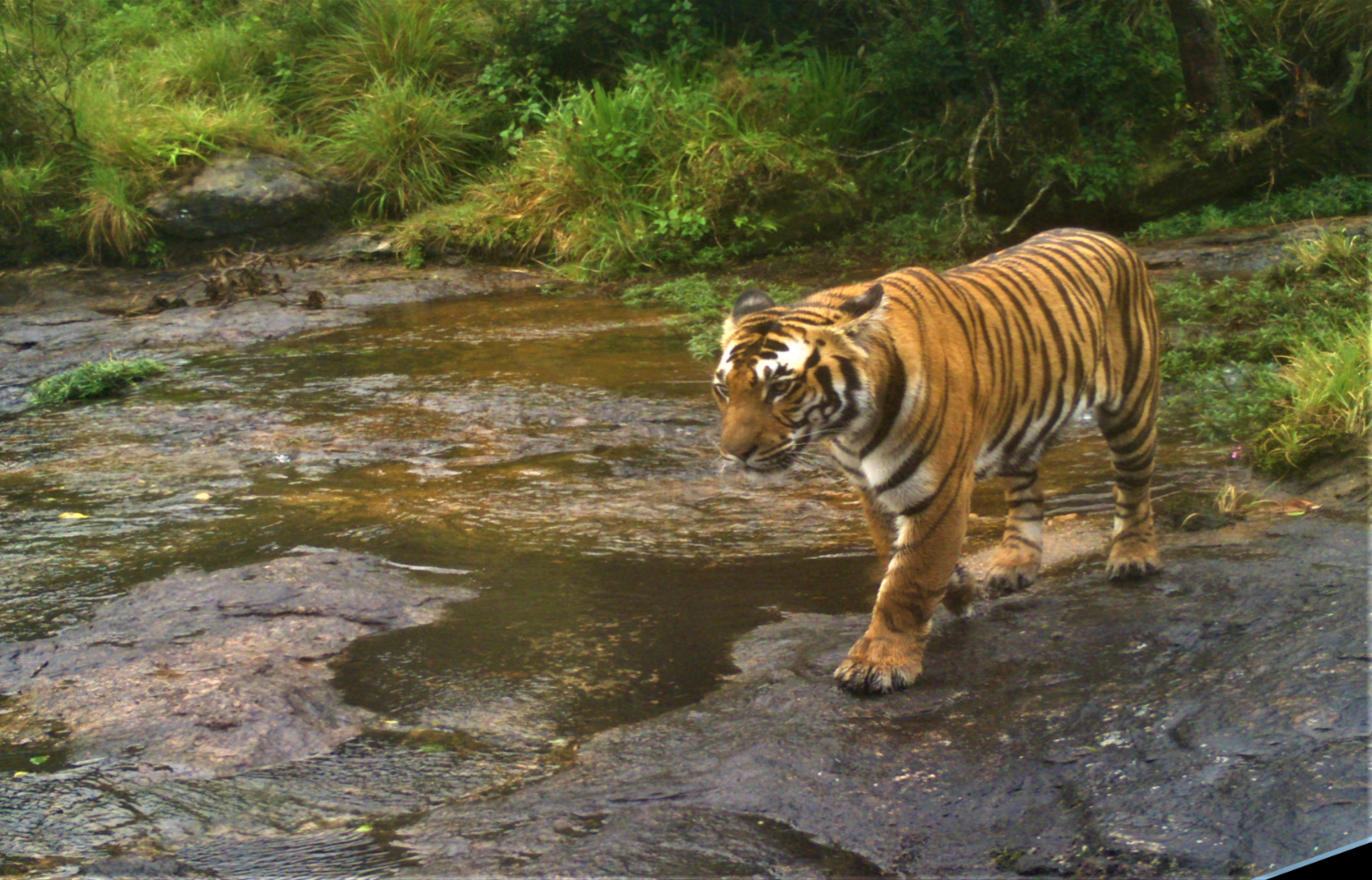
- The Annamalai Tiger Reserve is situated in the southwestern part of the state of Tamil Nadu and extends into the state of Kerala. It covers an area of approximately 1,459 square kilometers
- ATR is known for its rich biodiversity and is home to a wide variety of flora and fauna. It is considered one of the biodiversity hotspots in the Western Ghats.
- The reserve is particularly famous for its elephant population and is a vital habitat for several other species, including tigers, leopards, gaurs, sambar deer, and many types of birds and reptiles.
- ATR is designated as a tiger reserve, which means it plays a crucial role in the conservation of the Bengal tiger. It is part of the larger Western Ghats landscape, which is an important area for tiger conservation
The Annamalai Tiger Reserve (ATR) is known for its diverse flora, and it is part of the Western Ghats, a region recognized for its high biodiversity and endemism. The Western Ghats is also a UNESCO World Heritage Site. The flora of the Annamalai Tiger Reserve includes a wide variety of plant species, and here are some of the prominent ones:
-
Evergreen and Semi-Evergreen Forests: A significant portion of ATR is covered by evergreen and semi-evergreen forests. These forests are characterized by dense vegetation that remains green throughout the year. They consist of a wide array of tree species, including:
- Rosewood (Dalbergia latifolia): A valuable timber tree.
- Teak (Tectona grandis): Known for its high-quality timber.
- Malabar Kino (Pterocarpus marsupium): A deciduous tree with medicinal properties.
-
Grasslands: Grasslands are also found in the lower elevations of ATR. They provide grazing grounds for herbivores and support a variety of grass species and wildflowers.
-
Bamboo Groves: Bamboo is a prominent component of the flora in ATR. It includes various species of bamboo such as Bambusa arundinacea, Dendrocalamus strictus, and others. These provide habitat and food for several wildlife species.
-
Shola Forests: In the higher elevations, you can find Shola forests. These unique montane forests are often surrounded by grassy high-altitude plateaus known as "sholas." They are characterized by stunted trees and contain several endemic plant species.
-
Orchids: The Western Ghats, including ATR, is known for its rich orchid diversity. There are numerous species of orchids found in the region, many of which are endemic.
-
Medicinal Plants: ATR is home to several medicinal plants used by indigenous communities for traditional healing practices. These include species like Nothapodytes nimmoniana, which is used in the treatment of cancer.
-
Lichens and Mosses: ATR's diverse microclimates support a variety of lichens and mosses on trees and rocks.
-
Epiphytes: The trees in the rainforests of ATR are often covered with epiphytic plants like ferns, mosses, and orchids. These plants grow on the surface of other plants, utilizing them for support.
The Annamalai Tiger Reserve (ATR) is home to a diverse range of wildlife species, making it an important conservation area in the Western Ghats. Here are some of the notable fauna found in the Annamalai Tiger Reserve:
-
Bengal Tiger (Panthera tigris tigris)
-
Indian Elephant (Elephas maximus)
-
Indian Leopard (Panthera pardus fusca)
-
Indian Gaur (Bos gaurus)
-
Sambar Deer (Rusa unicolor)
-
Spotted Deer (Axis axis)
-
Indian Wild Dog (Cuon alpinus)
-
Indian Sloth Bear (Melursus ursinus)
-
Indian Pangolin (Manis crassicaudata)
-
Nilgiri Langur (Semnopithecus johnii)
-
Lion-tailed Macaque (Macaca silenus)
-
Malabar Giant Squirrel (Ratufa indica)
-
Indian Porcupine (Hystrix indica)
-
Indian Muntjac (Muntiacus muntjak)
The Annamalai Tiger Reserve (ATR) is inhabited by several indigenous tribal communities who have lived in the region for generations. These tribal communities have a deep connection with the forests and natural resources of the area. Some of the prominent tribes inhabiting the ATR and its surrounding regions include:
-
Toda Tribe: The Toda people are one of the indigenous tribes of the Nilgiris, a region that includes the Western Ghats, where ATR is located. They are known for their unique culture and traditional practices. The Toda people have their own language and are traditionally involved in buffalo herding.
-
Kota Tribe: The Kota tribe is another indigenous group living in the Nilgiris. They have a distinct culture and are traditionally involved in agriculture. The Kota people are skilled in the cultivation of various crops.
-
Kurumba Tribe: The Kurumba tribe is found in the Western Ghats region, including the ATR. They have a deep understanding of the forest and are known for their knowledge of herbal medicine. Some Kurumba people work as forest guides and have become valuable contributors to ecotourism in the area.
-
Irula Tribe: The Irula tribe is found in various parts of Tamil Nadu, including the regions around the ATR. They have a rich cultural heritage and are skilled in activities like snake catching, which has been a traditional occupation for some.
-
Malasar Tribe: The Malasar people are indigenous to the Nilgiris and the surrounding areas. They traditionally relied on shifting agriculture and forest resources for their livelihoods.
-
Mudugar Tribe: The Mudugar people are another tribal community in the Western Ghats region. They have a strong connection to the forests and have traditionally practiced agriculture and collection of forest produce.
-
Paliyan Tribe: The Paliyan people are found in the ATR and surrounding areas. They are known for their knowledge of the forest ecosystem and are skilled hunters and gatherers.
India is home to several tiger reserves, each established to protect and conserve the population of Bengal tigers and their habitats. These tiger reserves play a crucial role in the conservation of this endangered species. Here are some of the notable tiger reserves in India:
-
Jim Corbett National Park and Tiger Reserve (Uttarakhand): Established in 1936, it is India's oldest national park and a prominent tiger reserve, located in the foothills of the Himalayas.
-
Bandipur Tiger Reserve (Karnataka): Part of the Nilgiri Biosphere Reserve, Bandipur is known for its diverse wildlife and lush forests.
-
Ranthambhore Tiger Reserve (Rajasthan): Famous for its historic Ranthambhore Fort and the tigers that roam its surroundings, this reserve is a popular tourist destination.
-
Kanha Tiger Reserve (Madhya Pradesh): The inspiration behind Rudyard Kipling's "The Jungle Book," Kanha is known for its lush sal and bamboo forests.
-
Sundarbans Tiger Reserve (West Bengal): The Sundarbans is a unique mangrove forest and a UNESCO World Heritage Site, home to the elusive Royal Bengal tiger.
-
Periyar Tiger Reserve (Kerala): Located in the Western Ghats, it is known for its pristine forests, boating in the Periyar Lake, and the presence of tigers.
-
Buxa Tiger Reserve (West Bengal): Located in the Eastern Himalayas, Buxa is known for its rich biodiversity and historical significance.
-
Simlipal Tiger Reserve (Odisha): Located in the Mayurbhanj district, this reserve is known for its diversity of flora and fauna.
-
Satpura Tiger Reserve (Madhya Pradesh): Part of the Satpura Range, this reserve is known for its unique landscapes and tiger conservation efforts.
-
Indravati Tiger Reserve (Chhattisgarh): Located in the southern part of the state, this reserve is known for its biodiversity and the Indravati River.
-
Nagarjunsagar-Srisailam Tiger Reserve (Andhra Pradesh and Telangana): This reserve is one of the largest in India and spans across both Andhra Pradesh and Telangana, offering habitat to tigers and a variety of other wildlife.
-
Pench Tiger Reserve (Madhya Pradesh and Maharashtra): The Pench River flows through this reserve, which is known for its thriving tiger population.
-
Dudhwa Tiger Reserve (Uttar Pradesh): Located on the border with Nepal, Dudhwa is known for its grasslands and unique terai ecosystem.
-
Valmiki Tiger Reserve (Bihar): This reserve is located in the Terai region and provides important habitat for tigers and other wildlife.
-
Tadoba Andhari Tiger Reserve (Maharashtra): Known for its rich biodiversity, this reserve is a popular destination for wildlife enthusiasts.
|
For Prelims: Tiger Reserves, Project Tiger
For Mains: Flora and Fauna of Tiger reserves in India, Initiatives to Protect population of Tigers
|
|
Previous Year Questions
1.Which one of the following tiger reserves of India has ‘Bhoorsingh the Barasingha’ as its official mascot? (UPSC CAPF 2017)
A. Nameri tiger reserve
B. Ranthambhore tiger reserve
C. Panna tiger reserve
D. Kanha tiger reserve
Answer (D)
|
BABA FARID-JERUSALEM
- Legend has it that Baba Farid, a Sufi saint from Punjab, spent 40 days in deep meditation at this place.
- Although he returned to Punjab, Indian Muslims going to Mecca started visiting the walled city of Jerusalem to pray at this spot
- Over time, this place transformed into a shrine and a hospice for travelers from India.
- Baba Farid, born in 1173 CE in the village of Kothewal near Multan, hailed from a family that had migrated from Kabul to Punjab.
- He followed the Chishti order and, was one of the first Sufi saints to write his verses in Punjabi. Many of these verses are enshrined in the Guru Granth Sahib, the holy book of Sikhs.
- During his travels in Punjab and beyond, he visited Jerusalem, where he prayed at the Al-Aqsa mosque and composed verses
- Lore has it that he found a modest lodge within one of the gates of Old Jerusalem, known as Bab-az-Zahra among Muslims and Herod’s Gate among Christians
- This lodge was situated within a compact khanqah dedicated structures for Sufi orders, serving as both seminaries for the order’s followers, and hospices for travelers atop a small hillock within Herod’s Gate
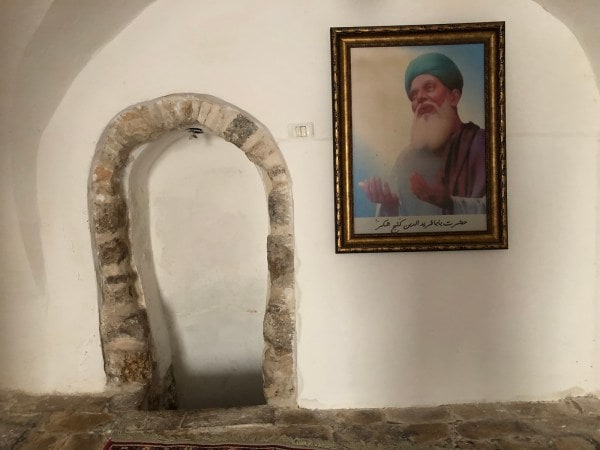
- After Baba Farid’s departure, the khanqah evolved into a hospice for travellers from India, earning the name Zawiya Al-Hindiya, meaning “the Lodge of Hind.”
- Remarkably, despite changing hands, including Christian crusaders, Mamluks, and Ottoman rulers, the lodge retained its association with India
- The medieval traveller Evliya Chelebi described Zawiya Al-Hindiya—the Indian hospice as one of the largest Zawiyas in the city in 1671
- Navtej Sarna, a diplomat-author, uncovered a document from 1681 that detailed a leadership dispute over the lodge, and another document mentioned a sheikh named Ghulam Mohammad Al-Lahori who engaged with the Ottoman administration in 1824, resulting in the expansion of the lodge’s facilities
- The lodge’s prominence continued during the Ottoman rule, primarily under sheikhs from South Asia. However, a significant shift occurred when the Ottoman Empire’s dissolution began in 1919.
- By 1921, the Grand Mufti of Jerusalem, Amin Al-Husayni, took charge and initiated extensive renovations and rebuilding efforts. To fund these projects, the Grand Mufti sought support from Muslim patrons worldwide, including the Muslim princely states in British India
- In 1921, the Grand Mufti informed leaders of the Indian Khilafat Movement about the ‘Indian Lodge’ in dire need of repair. Khwaja Nazir Hasan Ansari, a young man from Saharanpur, Uttar Pradesh, took on the task.
- By 1924, he had completely renovated the lodge, which provided sanctuary to numerous travellers and pilgrims from British India for the next 15 years. During World War II in 1939, the lodge served as a refuge for soldiers from British India fighting in North Africa.
- After India gained independence, Nazir Ansari sought official recognition for the lodge from the Indian embassy in Egypt, cementing its Indian identity.
- The lodge has faced several conflicts, enduring rocket strikes in 1952 and the Six Day War in 1967
- Over time, the Indian Hospice expanded to its current 7,000 square metres. It also hosts the United Nations Relief and Works Agency for Palestine Refugees (UNRWA) and the Jerusalem Health Centre within its premises
- In 2000, the hospice was the site of a meeting between former Indian Foreign Minister Jaswant Singh and Palestinian leader Faisal Husseini
SUPER BLUE MOON
Rakhi is celebrated on the Purnima of the month of Shravan — on August 30-31 will be unusual: it will be both a “blue moon” and a “super moon” and therefore, a “Super Blue Moon”, a rare trifecta of astronomical events.
This special moon will rise at 6.35 pm in Delhi on August 30, a little later in Mumbai, and about an hour earlier in Kolkata.

2. What is a Super moon?
- The orbit of the moon around the earth is not circular; it is elliptical, that is, an elongated or stretched-out circle. It takes the moon 27.3 days to orbit the earth
- It is 29.5 days from new moon to new moon, though. This is because while the moon is orbiting the earth, both the earth and the moon are also moving around the sun and it takes additional time for the sun to light up the moon in the same way as it does at the beginning of every revolution around the earth
- The new moon is the opposite of the full moon it is the darkest part of the moon’s invisible phase, when its illuminated side is facing away from the earth
- The point closest to earth in the moon’s elliptical orbit is called perigee, and the point that is farthest is called apogee.
- A super moon happens when the moon is passing through or is close to its perigee, and is also a full moon
- A full moon occurs when the moon is directly opposite the sun (as seen from earth), and therefore, has its entire day side lit up.
- The full moon appears as a brilliant circle in the sky that rises around sunset and sets around sunrise.
- The moon appears ‘full’ not just on Purnima, but also on the night before and after the full moon night
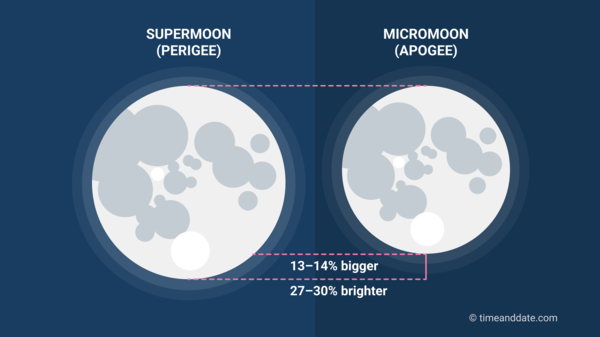
- The term "blue moon" has two meanings. It can refer to a second full moon in a single calendar month, which is a rare occurrence. It can also refer to the third full moon in a season that has four full moons, which happens about every 2.7 years
- The second definition is the more common one, and it is the one that is used in the phrase "once in a blue moon". This phrase means that something happens very rarely.
- The moon does not actually turn blue during a blue moon. The name comes from the way that the Old English word "belewe" (meaning "betrayer") was sometimes used to refer to a second full moon in a month.
- This is because the second full moon would "betray" the farmers who were using the lunar cycle to plant their crops
- A true blue moon, when the moon actually appears blue, is a very rare occurrence. It can happen when the moon passes through dust particles from a volcanic eruption or forest fire.
- The dust particles scatter red light, making the moon appear blue.
- The next blue moon will occur on August 19, 2024. It will be a seasonal blue moon, which means that it will be the third full moon in the summer season
- Sometimes, smoke or dust in the air can scatter red wavelengths of light, as a result of which the moon may, in certain places, appear more blue than usual. But this has nothing to do with the name “blue” moon
- Speaking of colours, you may have noticed that the moon appears more yellow/ orange when it is lower in the sky (closer to the horizon)
- This is because moonlight travels for longer through the atmosphere at this stage, and along the way, more of the shorter, bluer wavelengths of light are scattered, leaving more of the longer, redder wavelengths.
- The NASA explainer points out that dust or pollution can end up deepening the reddish colour of the moon
- According to NASA, a full moon at perigee (super moon) is about 14% bigger and 30% brighter than a full moon at apogee (called a “micro moon”).
- However, it is unlikely the difference in size will be noticeable by most people.
- The moon could appear somewhat brighter, though but whether you are able to make out the difference will depend on factors such as the so-called ‘Moon illusion’, and how cloudy or polluted it is at your location
COMPREHENSIVE NUCLEAR TEST BAN TREATY (CTBT)
1. Context
2. What is the Comprehensive Test Ban Treaty (CTBT)?
The CTBT is a multilateral treaty that prohibits all nuclear explosions, for both civilian and military purposes, in all environments. It was adopted by the United Nations General Assembly on September 10, 1996, but has not yet entered into force because it has not been ratified by all 44 states required to do so, including eight specific nations: China, India, Pakistan, North Korea, Israel, Iran, Egypt, and the United States.
3. The purpose of the Comprehensive Test Ban Treaty
The CTBT has several important purposes:
- To prevent the development of new nuclear weapons and the improvement of existing arsenals.
- To reduce the risk of nuclear proliferation.
- To promote international peace and security.
- To build trust and confidence between states.
- To promote transparency and accountability in the nuclear sphere.
4. How did CTBT come into being?
- 1945: US conducts the world's first successful nuclear test.
- 1949: Soviet Union tests its first nuclear weapon, triggering a Cold War arms race.
- 1945-1996: Over 2,000 nuclear tests; 1,032 by the US, 715 by the Soviet Union, 45 by Britain, 210 by France, and 45 by China.
- Concerns grow globally about the health and environmental effects of radioactive fallout.
- 1963: Limited Nuclear Test-Ban Treaty (LTBT) bans nuclear tests in the atmosphere, outer space, and underwater but allows underground tests.
- 1968: No agreement on a comprehensive test ban during the negotiation of the Nuclear Nonproliferation Treaty.
- 1974: The US and Soviet Union signed the Threshold Test Ban Treaty (TTBT) limiting tests to yields under 150 kilotons.
- 1990s: Cold War ends, leading to a breakthrough.
- 1996: The Comprehensive Nuclear-Test-Ban Treaty (CTBT) is adopted by the UN, banning all explosive nuclear weapon tests.
- CTBT opened for signature on September 24, 1996.
5. India, USA, NPT and CTBT-Issues and India’s Apprehension
India is one of the eight key countries that have not ratified the CTBT. India has expressed several concerns about the treaty, including the following:
- India believes that the CTBT will hinder its ability to develop and maintain a credible nuclear deterrent against Pakistan and China.
- India believes that the CTBT discriminates against non-nuclear-weapon states by denying them the right to develop nuclear weapons for peaceful purposes, such as nuclear power generation.
- India is concerned about the effectiveness of the CTBT's verification regime, particularly because some nuclear-weapon states have not yet ratified the treaty.
The United States has also not ratified the CTBT. The US Senate rejected the treaty in 1999, citing concerns about the treaty's verification regime and the impact it would have on US nuclear security.
The Nuclear Non-Proliferation Treaty (NPT) is an international treaty aimed at preventing the spread of nuclear weapons and weapons technology and promoting the peaceful use of nuclear energy. The CTBT is complementary to the NPT, as it helps to prevent the development and improvement of nuclear weapons.
6. Growing Global Concern
The radioactive fallout from these tests raised concerns worldwide about the impact on health and the environment. In response, several attempts were made to restrict nuclear testing, including the 1963 Limited Nuclear Test-Ban Treaty (LTBT), which prohibited atmospheric, outer space, and underwater tests but still allowed underground tests.
7. Impact of CTBT on Nuclear Testing
Since the CTBT came into existence, only 10 nuclear tests have taken place. India conducted two in 1998, Pakistan conducted two in 1998, and North Korea conducted tests in 2006, 2009, 2013, 2016 (twice), and 2017. The United States last conducted a nuclear test in 1992, while China and France did so in 1996. The Soviet Union conducted its final test in 1990, and Russia, inheriting most of the Soviet nuclear arsenal, has never conducted a nuclear test.
8. Conclusion
The CTBT is an important treaty for the international community, and its entry into force would be a significant step towards a more peaceful and secure world. However, India has several apprehensions about the treaty, which have prevented it from ratifying it. It is important to address India's concerns to achieve the goal of a nuclear-weapon-free world.
|
For Prelims: Comprehensive Nuclear Test Ban Treaty, Soviet Union, Russia, India, USA, United Nations, Nuclear Tests, Limited Nuclear Test-Ban Treaty, Non-Proliferation Treaty, Partial Test Ban Treaty,
For Mains:
1. Explain India's apprehensions and concerns regarding the CTBT and its impact on the country's nuclear deterrence policy. How can these concerns be addressed to promote India's participation in the treaty? (250 words)
|
|
Previous Year Questions
Prelims1. Comprehensive Test Ban Treaty (CTBT) is associated with the ban on which of the following? (Rajasthan PTET 2012)
A. Ban on certain organisations under UN laws
B. Ban on money laundering activities
C. Ban on nuclear tests for developing arsenals
D. Ban on terrorism
Answer: C
2. What is/are the consequence/consequences of a country becoming the member of the ‘Nuclear Suppliers Group’? (2018)
Which of the statements given above is/are correct? (a) 1 only (b) 2 only (c) Both 1 and 2 (d) Neither 1 nor 2 Answer: A 3. Consider the following countries: (UPSC 2015)
Which among the above are Nuclear Weapons States as recognized by the Treaty on the Non-Proliferation of Nuclear Weapons, commonly known as Nuclear Non-Proliferation Treaty (NPT)? (a) 1 and 2 only (b) 1, 3, 4 and 5 only (c) 2, 4 and 5 only (d) 1, 2, 3, 4 and 5 Answer: A 4. The Soviet Union broke down in the year _______. (SSC GD 2019) A. 1991 B. 1880 C. 2000 D. 1900 Answer: A 5. What is the code name of the first Nuclear test of India? (MP Police SI 2016) A. Chagai 1-1 B. Smiling Buddha C. Project 596 D. Shakti 1 – 1 Answer: B Mains1. In what ways would the ongoing U.S-Iran Nuclear Pact Controversy affect the national interest of India? How should India respond to this situation? (UPSC 2018) 2. With growing energy needs should India keep on expanding its nuclear energy programme? Discuss the facts and fears associated with nuclear energy. (UPSC 2018) 3. Give an account of the growth and development of nuclear science and technology in India. What is the advantage of fast breeder reactor programme in India? (UPSC 2017) |
CUBISM
- First, Cubism has nothing to do with cubes. The name ‘cubism’ seems to be derived from a snide comment by French artist Henri Matisse (1869-1954), who called one of Braque’s paintings “a picture made up of small cubes”
- Unlike its predecessors, Cubism involved artists seeing an object not from a single viewpoint but from every conceivable angle.
- It was the rejection of the traditional approach to making art, where art was just a copy of nature or an object and the artists adopted age-old techniques of perspective, modelling, and foreshortening.
- Cubism is about acknowledging the two-dimensional nature of the canvas and categorically NOT about trying to re-create the illusion of three dimensions (a cube, for example)
- If Picasso and Braque were to paint a cardboard box, they would metaphorically take it apart and open it to make a flat plan, Gompertz added.
- This helped show all sides of the box at once. However, the artists would also want their composition to showcase the box’s three-dimensionality on the canvas, which the flat plane can’t do.
- So they took an imaginary walk around the box and chose the views they felt best described the object before them.
- They would then paint and rearrange these ‘views’ or ‘pieces’ on the canvas in a series of interlocking flat planes. The order was a rough approximation of the box’s original three-dimensional shape, so that it was still discernible as a cube but laid out in two dimensions
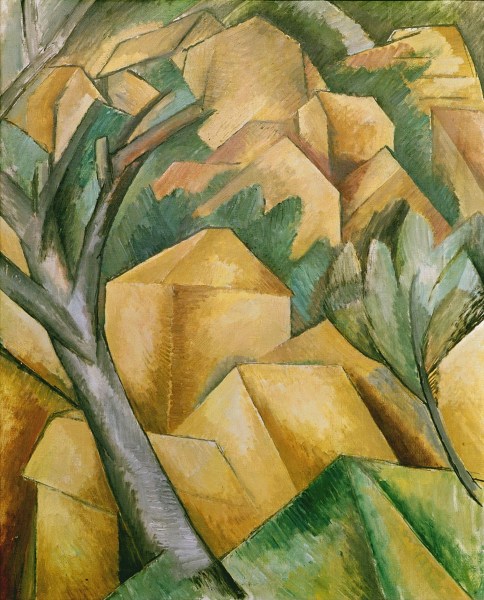
- By doing this, Picasso and Braque thought their art would invoke “a much stronger feeling of recognition” about the box or any other subject artists might create.
- Cubism was meant to make people pay more attention to everyday objects that were usually overlooked and present a more precise representation of how people actually perceive an object
- Both Picasso and Braque took inspiration from the later works of French artist Paul Cézanne. As a Post-Impressionist painter, Cézanne began to represent nature with geometric shapes.
- For instance, a tree was painted as a combination of cylinders and an apple was a sphere. This mode of making art was central to the early development of Cubism
- Cubism was also very much a reflection of the groundbreaking developments in science and technology during the early 1900s
- Picasso and Braque were aware of Albert Einstein’s Special Theory of Relativity, published in 1905, in which the scientist proposed that space and time don’t exist as independent entities, combining the three dimensions (height, width and depth) of space and one dimension of time into a single four-dimensional continuum, known as spacetime
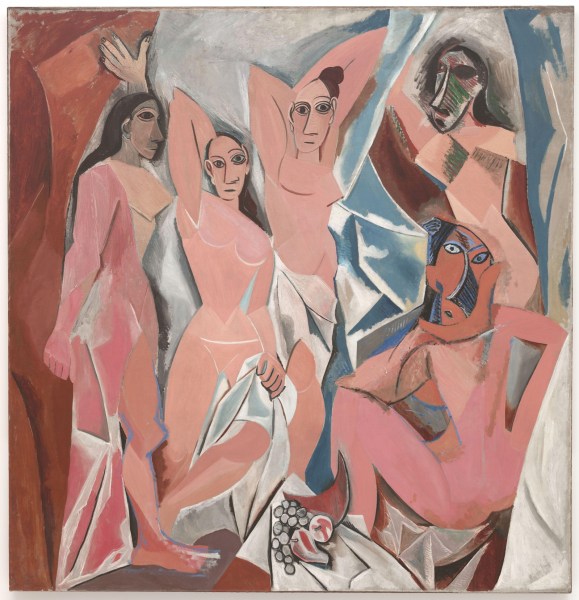
- The art movement developed in two distinct phases, including the initial analytical cubism, and a later phase known as synthetic cubism, according to a report by Tate Museum
- Artworks made during the analytical cubism phase (1907-1912) mostly displayed objects from different viewpoints (as discussed before), painted in mute tones of blacks, greys and ochres
- The synthetic cubism phase (1912-1914) involved simpler shapes and brighter colours in comparison to the aforementioned phase.
- Most significantly, however, it also entailed the use of real-life objects Picasso and Braque incorporated wallpapers, newspaper cuttings, and oilcloths into their paintings.
- They used the technique to not only make Cubist paintings more legible but also to elevate the status of objects like an oilcloth from worthless rags to something unique and valuable.




